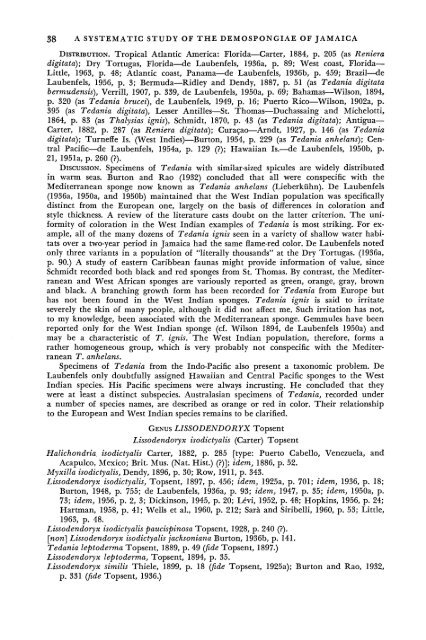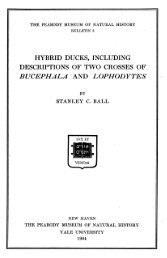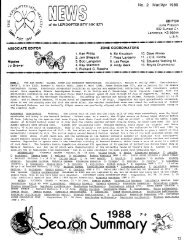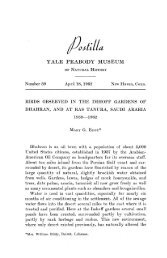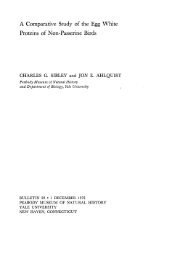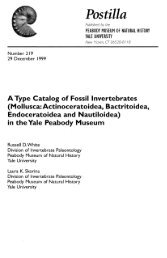Bulletin 20 - Peabody Museum of Natural History - Yale University
Bulletin 20 - Peabody Museum of Natural History - Yale University
Bulletin 20 - Peabody Museum of Natural History - Yale University
Create successful ePaper yourself
Turn your PDF publications into a flip-book with our unique Google optimized e-Paper software.
38 A SYSTEMATIC STUDY OF THE DEMOSPONGIAE OF JAMAICA<br />
DISTRIBUTION. Tropical Atlantic America: Florida—Carter, 1884, p. <strong>20</strong>5 (as Reniera<br />
digitata); Dry Tortugas, Florida—de Laubenfels, 1936a, p. 89; West coast, Florida—<br />
Little, 1963, p. 48; Atlantic coast, Panama—de Laubenfels, 1936b, p. 459; Brazil—de<br />
Laubenfels, 1956, p. 3; Bermuda—Ridley and Dendy, 1887, p. 51 (as Tedania digitata<br />
bermudensis), Verrill, 1907, p. 339, de Laubenfels, 1950a, p. 69; Bahamas—Wilson, 1894,<br />
p. 3<strong>20</strong> (as Tedania brucei), de Laubenfels, 1949, p. 16; Puerto Rico—Wilson, 1902a, p.<br />
395 (as Tedania digitata), Lesser Antilles—St. Thomas—Duchassaing and Michelotti,<br />
1864, p. 83 (as Thalysias ignis), Schmidt, 1870, p. 43 (as Tedania digitata)) Antigua—<br />
Carter, 1882, p. 287 (as Reniera digitata); Curasao—Arndt, 1927, p. 146 (as Tedania<br />
digitata); Turneffe Is. (West Indies)—Burton, 1954, p. 229 (as Tedania anhelans); Central<br />
Pacific—de Laubenfels, 1954a, p. 129 (?); Hawaiian Is.—de Laubenfels, 1950b, p.<br />
21, 1951a, p. 260 (?).<br />
DISCUSSION. Specimens <strong>of</strong> Tedania with similar-sized spicules are widely distributed<br />
in warm seas. Burton and Rao (1932) concluded that all were conspecific with the<br />
Mediterranean sponge now known as Tedania anhelans (Lieberkiihn). De Laubenfels<br />
(1936a, 1950a, and 1950b) maintained that the West Indian population was specifically<br />
distinct from the European one, largely on the basis <strong>of</strong> differences in coloration and<br />
style thickness. A review <strong>of</strong> the literature casts doubt on the latter criterion. The uniformity<br />
<strong>of</strong> coloration in the West Indian examples <strong>of</strong> Tedania is most striking. For example,<br />
all <strong>of</strong> the many dozens <strong>of</strong> Tedania ignis seen in a variety <strong>of</strong> shallow water habitats<br />
over a two-year period in Jamaica had the same flame-red color. De Laubenfels noted<br />
only three variants in a population <strong>of</strong> "literally thousands" at the Dry Tortugas. (1936a,<br />
p. 90.) A study <strong>of</strong> eastern Caribbean faunas might provide information <strong>of</strong> value, since<br />
Schmidt recorded both black and red sponges from St. Thomas. By contrast, the Mediterranean<br />
and West African sponges are variously reported as green, orange, gray, brown<br />
and black. A branching growth form has been recorded for Tedania from Europe but<br />
has not been found in the West Indian sponges. Tedania ignis is said to irritate<br />
severely the skin <strong>of</strong> many people, although it did not affect me. Such irritation has not,<br />
to my knowledge, been associated with the Mediterranean sponge. Gemmules have been<br />
reported only for the West Indian sponge (cf. Wilson 1894, de Laubenfels 1950a) and<br />
may be a characteristic <strong>of</strong> T. ignis. The West Indian population, therefore, forms a<br />
rather homogeneous group, which is very probably not conspecific with the Mediterranean<br />
T. anhelans.<br />
Specimens <strong>of</strong> Tedania from the Indo-Pacific also present a taxonomic problem. De<br />
Laubenfels only doubtfully assigned Hawaiian and Central Pacific sponges to the West<br />
Indian species. His Pacific specimens were always incrusting. He concluded that they<br />
were at least a distinct subspecies. Australasian specimens <strong>of</strong> Tedania, recorded under<br />
a number <strong>of</strong> species names, are described as orange or red in color. Their relationship<br />
to the European and West Indian species remains to be clarified.<br />
GENUS LISSODENDORYX Topsent<br />
Lissodendoryx isodictyalis (Carter) Topsent<br />
Halichondria. isodictyalis Carter, 1882, p. 285 [type: Puerto Cabello, Venezuela, and<br />
Acapulco, Mexico; Brit. Mus. (Nat. Hist.) (?)]; idem, 1886, p. 52.<br />
Myxilla isodictyalis, Dendy, 1896, p. 30; Row, 1911, p. 343.<br />
Lissodendoryx isodictyalis, Topsent, 1897, p. 456; idem, 1925a, p. 701; idem, 1936, p. 18;<br />
Burton, 1948, p. 755; de Laubenfels, 1936a, p. 93; idem, 1947, p. 35; idem, 1950a, p.<br />
73; idem, 1956, p. 2, 3; Dickinson, 1945, p. <strong>20</strong>; L£vi, 1952, p. 48; Hopkins, 1956, p. 24;<br />
Hartman, 1958, p. 41; Wells et al., 1960, p. 212; Sara and Siribelli, 1960, p. 53; Little,<br />
1963, p. 48.<br />
Lissodendoryx isodictyalis paucispinosa Topsent, 1928, p. 240 (?).<br />
[non] Lissodendoryx isodictyalis jacksoniana Burton, 1936b, p. 141.<br />
Tedania leptoderma Topsent, 1889, p. 49 (fide Topsent, 1897.)<br />
Lissodendoryx leptoderma, Topsent, 1894, p. 35.<br />
Lissodendoryx similis Thiele, 1899, p. 18 (fide Topsent, 1925a); Burton and Rao, 1932,<br />
p. 331 (fide Topsent, 1936.)


